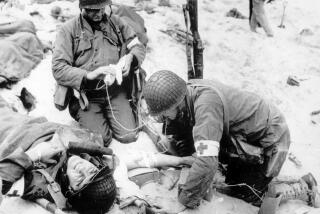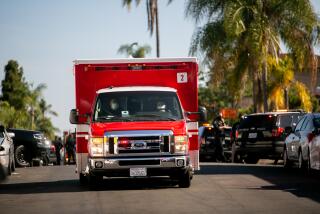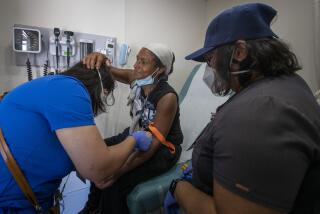Medical Move Cut Combat Deaths in Iraq, Navy Reports
SAN DIEGO — The U.S. Navy’s decision to put medical teams closer to the battlefield in Iraq than in previous wars led to a decrease in combat fatalities among Marines, naval doctors told a military medical symposium Tuesday.
“We really have done something right,” said Vice Adm. Michael Cowan, the Navy’s surgeon general, of the new approach, which reduced the time that wounded Marines had to wait for care.
In addition, Navy doctors, nurses and hospital corpsmen benefited from emergency room training they received at Los Angeles County-USC Medical Center in treating gunshot and other deep penetration wounds, officials said.
The center was chosen from 63 hospitals bidding to train Navy medical personnel in “salvage surgery.” One factor in its selection was the high volume of trauma patients seen at L.A. County-USC, including people on the verge of death from wounds similar to those seen in combat.
“We don’t get combat pay in L.A. but we should,” joked Navy Cmdr. Peter Rhee. The training program began last year. The Air Force has a similar program at a civilian hospital in Baltimore, and the Army at a facility in Miami.
Both the mobile medical units and the trauma training programs grew out of concerns after the 1991 Persian Gulf War that the military was not prepared to treat large numbers of casualties spread over a moving battlefield. The issue was the subject of congressional hearings.
Some Navy planners had questioned whether putting medical personnel closer to combat would be worth the expense and risk and had worried that the move would spread the medical teams too thin to be effective.
But statistics have shown the effort to have been successful, officials told the symposium, titled “Military Trauma Care: Lessons From Operation Iraqi Freedom,” held at the Naval Medical Center here.
Initial indications are that only 1% of wounded Marines who were brought to one of the Forward Resuscitation Surgical System units on the edge of the battlefields did not survive. In other wars, that figure has ranged from 2.5% to 8%, officials said.
During the principal combat in Iraq, 243 of the 246 Marines treated for wounds survived. Three Marines died despite receiving treatment, while 55 others were killed on the battlefield.
“If we can get them there, they have a 99% chance of going home alive,” said Capt. H.R. Bohman, a Navy doctor who treated wounded Marines and Iraqis. “I like those odds.”
Under the new system, eight-person medical teams moved along with combat units, pitching tents filled with medical gear and portable operating tables on the edge of where fighting was underway. Some units moved as many as a dozen times and came within three miles of the fighting as Marines pushed to Baghdad and then on to the northern Iraqi city of Tikrit.
The goal was to ensure that wounded Marines received emergency care within the first 60 minutes of being injured, the so-called golden hour. The system has been touted as the biggest innovation in combat care since the development of MASH mobile hospitals during the 1950-53 Korean War.
While there were problems in Iraq with getting supplies as units moved, communicating with physicians at other locations and evacuating the wounded, the Marine Corps says the new system set a standard for how wounded troops will be treated in future wars. The Navy provides medical care for the Marines.
To ensure that the wounded received care as soon as possible, the Marine Corps, although chronically short of aircraft for combat missions, assigned six helicopters to casualty evacuation duty.
“Without that we would not have gotten those casualties within that [golden hour] time,” said Navy Capt. Larry Roberts.
More to Read
Sign up for Essential California
The most important California stories and recommendations in your inbox every morning.
You may occasionally receive promotional content from the Los Angeles Times.










